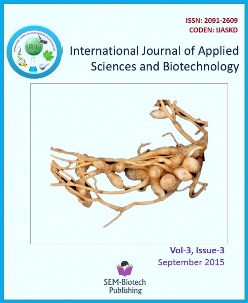Scenario of Entomological Research in Legume Crops in Nepal
DOI:
https://doi.org/10.3126/ijasbt.v3i3.13217Keywords:
Legumes, insect management, biological controlAbstract
This review paper highlights scenario of entomological research in grain legumes in Nepal into headings of the monitoring, survey and surveillance, insect pest management, existing problem and future strategies. A survey study on yield loss assessment of chickpea due to Helicoverpa pod borer under field condition has been recorded up to 75% in the year 1996-1998 at Banke and Bardiya district. While monitored Helicoverpa armigera through pheromone trap, during the 2nd week of March, peak catches of 91 male moths were recorded at Rampur, while it was the maximum (42 male moths) during the 3rd week of March. Synthetic pyrethroids, deltamethrin, fenvalerate and cypermethrin used at 0.01% concentration (a.i.), were effective in controlling the chickpea pod borer, Helicoverpa armigera Hubner. Genotypes NCH-18, NCH -31, NCH-138 and ICC 3075 WR were found resistant. Ripcord 10%@0.05% was found to be superior and effective chemical insecticides to control stem fly and soybean hairy caterpillar. The late sowing date December, 10 showed significantly higher percentage of chickpea pod borer damage with lower grain yield. Inter crops combinations of Chickpea +wheat (2:1) ratio was found effective against Helicoverpa armigera damage (1.2%) followed by chickpea+barley (2.36%) and Chickpea+linseed (2:1) ratio (3.7%). Bakaino (Melia azederach L.) was identified as the best indigenous pesticides to check the normal growth of hairy caterpillar (Spilarctia casigneta kollar) under laboratory condition. Metarhizium anisopliae was found effective for the management of Helicoverpa armigera that caused maximum mortality (94.67%), infection (45.33%) within 7.49 days (LT50). Similarly, Beauveria bassiana caused maximum mortality (98.67%), infection (80.00%) with the least LT50 value (5 days). Crop sprayed with HaNPV had the lowest pod damage (0.3%) and the highest in Racer (2.2%). This review work provided a lot of information to conduct entomological research activity conducted in grain legumes and opens the door for future research and strategy.
Int J Appl Sci Biotechnol, Vol 3(3): 367-372




